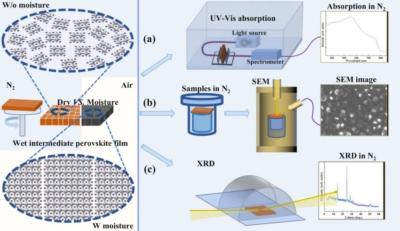Perovskite-Info weekly newsletter
Published: Tue, 08/30/22
The Perovskite-Info newsletter (August 30, 2022)
Cannot read this? View it online here
Researchers design method to control the properties of perovskite crystals towards efficient perovskite solar cells
Scientists from Taiwan's Industrial Technology Research Institute (ITRI) and National Yang Ming Chaio Tung University recently demonstrated a way to produce high-purity lead-iodide, as a precursor material for a perovskite solar cell. The team used temperature to better control the orientation of crystals, and managed to show much higher efficiencies when the precursor was used to fabricate a perovskite layer and subsequently a working solar cell.
The team worked on the fabrication of lead-iodide (PbI2), an element used in many of the highest-performing perovskite solar cells produced to date. They built on earlier research that has shown the purity and formation of this material could be a key factor in performance once it is integrated into a solar cell. The group’s recent work demonstrates how the crystalline structure and orientation of PbI2 have a significant impact on cell performance. The researchers also introduce a simple way to control this using temperature during synthesis.
Researchers develop strategy to improve perovskite absorbers for perovskite solar cells
Researchers at Soochow University, Sichuan University and Empa (Swiss Federal Laboratories for Materials Science and Technology), recently devised a new strategy to create high-quality perovskite absorbers with grains in the micrometer scale and prolonged carrier lifetimes. This new strategy is based on a close-space annealing (CSA) process, a heat-based technique that can be used to change a material's chemical properties.
According to the team, controllable crystallization plays a crucial role in the formation of high-quality perovskites. The researchers reported a universal CSA strategy that increases grain size, enhances crystallinity and prolongs carrier lifetimes in low-bandgap (low-Eg) and wide-bandgap (wide-Eg) perovskite films. The CSA strategy devised by the team is universal, as it can be applied to perovskites with various bandgaps to produce high-quality absorbers with enlarged grains and longer carrier lifetimes. As part of their recent study, the team demonstrated its generalizability by successfully using it to prepare absorbers based on perovskites with different chemical compositions.
Researchers observe the unique microstructure of a novel ferroelectric material for the first time
A team of researchers from from Penn State, the University of California, Oak Ridge National Laboratory and Rutgers University have observed, for what they say is the first time, the unique microstructure of a novel ferroelectric material, enabling the development of lead-free ferroelectric materials for electronics, sensors, and energy storage that are safer for human use.
Ferroelectrics are a class of materials that demonstrate a spontaneous electric polarization as the result of shifts of negative and positive charges that can be reoriented within the material with application of external force. They are especially useful for data storage and memory as they can remain in one polarized state without additional power, making them attractive for energy-saving data storage and electronics.
Researchers design a controllable moisture treatment for perovskite films
Scientists from China's Huaqiao University and Henan Normal University have developed a controllable moisture treatment for perovskite films that can promote the mass transportation of organic salts. The films were used to fabricate a 0.2 cm2 perovskite solar cell that was able to retain 80% of its initial efficiency after 1200 h.

The group investigated the effects of moisture in the air on the intermediate and final perovskite films in solar cells and developed the controllable moisture treatment that relies on a series of nitrogen (N2)-protected characterization techniques.
Researchers develop strategy for perovskite-based blue LEDs
A Florida State University research team, led by FSU Professor of Chemistry Biwu Ma, has developed a simple and effective approach to create an efficient and stable blue light from metal halide perovskites.
Scientists have already created highly efficient and stable perovskite-based LEDs for green and red light, but an efficient and stable blue light has been difficult to achieve. Blue light requires a lot of power, and the blue color purity often decreases over time. An efficient and stable blue light is crucial for creating white light.
Researchers develop perovskite-based photodetectors with excellent efficiencies and response times
Researchers at the University of Toronto and the Barcelona Institute of Science and Technology recently reported new solution-processed perovskite photodetectors that exhibit remarkable efficiencies and response times. The photodetectors have a unique design that prevents the formation of defects between its different layers.
The researchers explained that there are applications for which fast photodetection is required in wavelength ranges beyond human vision. "Silicon, the legacy approach—and ideal for electronic readout—does not on its own unite high efficiency with high-speed, as a result of its indirect bandgap, a property of silicon's band structure that produces weak absorption (hence a need for thick silicon) in the near infrared", said University of Toronto's Amin Morteza Najarian.
Metalgrass LTD
9 Har Tsin St.
Kfar Sava Hasharon 4430809
ISRAEL
Unsubscribe | Change Subscriber Options




